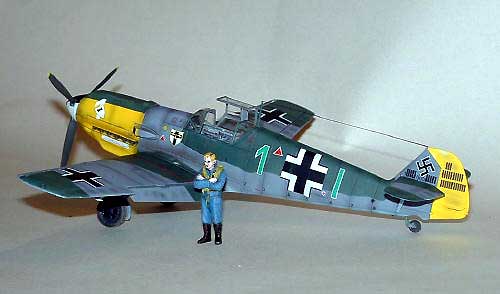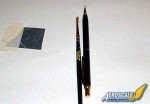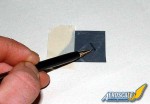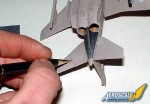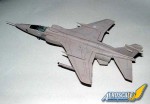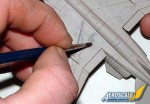1⁄35Panel Lines With Pencil Lead
I have received many compliments and questions on my method of weathering panel lines after I put pictures of my ME109E onto the aircraft forum so I thought I would do a step-by-step article on how simple this method is. The only constraints are that the kit should have recessed panel lines, the decals are applied with decal agents so they shrink into the panel lines, and the surface has a matt finish. The kit is built, painted, decaled and given a coat of matt varnish. It should then be left to dry for a couple of days for the varnish to completely harden. The canopy and underwing stores may be left off for ease of handling if desired. In this case I am using a 1/72 Tamiya Jaguar GR1 in Gulf War colours. The tools [pic1] used are: a piece of fine wet and dry paper taped to a flat surface, a fine soft bristled paintbrush, a propelling pencil [the type that uses fine 0.5mm lead]. The pencil is adjusted so that 4-5mm of lead is protruding and is then gently rubbed against the wet and dry to produce a sharp point. [pic2] Taking the model the panel lines are gently drawn in. Care should be taken not to press too hard, especially where decals cross the panel line. The point of the pencil will naturally follow the recessed line, if it slips out and leaves a line outside the recess this can be removed by lightly rubbing with an eraser. The lead will soon lose its sharp point so stop regularly and rub it on the wet and dry to sharpen it again. [pic3] Continue until all the panel lines are drawn in. [pic4] Take the brush and rub it into the powder left on the wet and dry paper when the pencil lead was sharpened. [pic5] Gently apply the powder by lightly brushing along the panel lines and also into recesses, in this case under the lower wing/fuselage joining and the ventral spine/fuselage joining. There may be excess powder that falls onto the surface of the kit, simply stop after doing each line and blow it away. If the powder runs out rub the pencil on the wet and dry paper to produce some more. Care should be taken from now on in handling the kit to avoid getting powder onto the fingers and then leaving fingerprints on the kit, I usually hold the kit by the leading and trailing edges of the wing. [pic6] Continue doing all the lines until the whole kit is done. If the powder seems too heavily done in places take a piece of clean masking tape, gently lay it on the area you are not happy with and slowly peal it off, it will remove much of the powder allowing you to redo the area. And that's all there is to it, this method is simplicity itself once done a couple of times and takes very little time, this kit took only 20 minutes to weather for this article. [pic7] With practice you will soon find that you can control how heavily the powder is applied and this technique can also be used to show exhaust stains on piston powered aircraft, cordite staining on wings where guns are mounted, as well as the staining that occurs on the underside of aircraft using grass airfields. Also I have mixed weathering powders in with the pencil lead powder to vary the effect with some success. I should add that I use this method instead of using a wash, I don't know whether the two methods will compliment each other, maybe someone will try and if the result is effective do another article. CommentsMartin, thank you for a clear, concise exposition of this method. It’s one I’ve been thinking about trying, but really didn’t know enough to actually attempt it. No excuses for me now.
Peter is right. If you’re not careful, you will make excellent modelers of us all !!
:-) :-)
Mike
MAR 27, 2004 - 08:15 AM
That is a great article...god job Martin you method is other way to do of accenting panel lines on kits.
Thank a lot and all the best for you friend.
From South America Venezuela.
Leal Antoniazzi Pedro.
[email protected]
MAR 27, 2004 - 11:59 AM
Thanks brandydoguk
I used this technique on my XWing from Fine Molds
I love it
 I applied a light coat of dullcote and as far as I can see its wonderful
I applied a light coat of dullcote and as far as I can see its wonderful APR 05, 2004 - 04:16 PM
I suppose this technique can be used on armor models as well? I've brushed powdered graphite on bare metal and engine parts before, also with good effect.
APR 06, 2004 - 02:27 PM
probably could be used on armor
It's kind of an "eye of the beholder" thing
But I sure thought it was great on my recessed panel lines.
Had to sand the pencil lead to keep it's ability to fit in to 1/72 scale panel lines, but I think the results were worth it.
APR 07, 2004 - 08:09 AM
Just used this technique for the first time on Dragon's SU-24. I'm really happy with the dirty uneven results that it gave me, although I would just mention that you should keep the size of the brush to a minimum unless you like having smudges everywhere (which I actually like, especially from viewing distances). It's also really easy to put fingerprints on it.
Stephen
MAY 25, 2004 - 02:01 AM
i've used this techniq before but i found it difficult specially when you run the pencil in the panel line (probly i got a shakey hands). i substitute the pencil with ink (rotring ink or any water base ink for tech pens). this is my techniq doing panel lines, in a small container (medicine cup) of water, add few drops of ink, 4-5 will be enough and add few drops of liquid soap. the soap will break the surface tension and you wash will flow freely down your panel. dont make your wash too dark because it will be difficult to control. on the first pass, the panel will be light in color, wait for few minutes to dry then you can repeat the whole process again. dont over do it, its better to add than to erase. but, the good thing about this wash, you can erase it with soap and water if you didn't like the result. you can also use your wash to represent oil streaks.
MAY 29, 2004 - 07:43 AM
Hai,
I can't see the pictures that come with this article.
I can see all other armorame pictures so I guess that soemthing is wrong with this page
JUN 24, 2006 - 07:29 PM
The images appear as a red X but if you click them they show properly as a pop-up picture.
JUN 24, 2006 - 08:53 PM
Hi all
Updating the images in Features is one of the big behind the scenes projects. The problem came about with the Gallery changes. We've been quietly working our way through several hundred old Reviews - and Features are next on the list.
Thanks for your patience on this one.
All the best
Rowan
JUN 25, 2006 - 12:13 AM
Copyright ©2021 by Martin. Images also by copyright holder unless otherwise noted. The views and opinions expressed herein are solely the views and opinions of the authors and/or contributors to this Web site and do not necessarily represent the views and/or opinions of AeroScale, KitMaker Network, or Silver Star Enterrpises. Images also by copyright holder unless otherwise noted. Opinions expressed are those of the author(s) and not necessarily those of AeroScale. All rights reserved. Originally published on: 2004-03-26 00:00:00. Unique Reads: 26715
|




